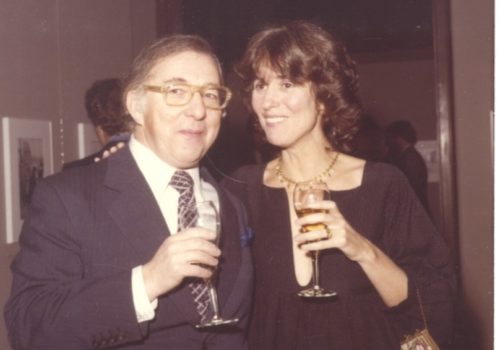Anna Winand was the assistant and Cornell Capa’s counterpart at the International Center of Photography, ICP NY. She brought rigor and efficiency to disorderly, flamboyant Cornell. She will write a monthly chronicle of her memories! – Jean-Jacques Naudet
Cornell Capa and Karl Katz became friends in 1972 when the Metropolitan Museum of Art opened an exhibition of photographs on China, Behind the Great Wall of China. Karl was then Chairman for Exhibitions and Loans at the Met and Cornell was the guest director of the exhibition. Coincidently, Karl shared the same birth date, October 25, with Robert Capa, a fact Cornell took very much to heart.
At that time I was working at a high school in Harlem. I took my young students to see the exhibit and accompanying film; they enjoyed it so much we made a second visit.
Karl was named one of New York City’s Most Eligible Bachelors in a group of ten by New York Magazine. More importantly for the International Center of Photography, he was the person who said Cornell needed an institution to continue doing all the things he was then doing from his walkup apartment on 28th Street in Manhattan. Things like curating exhibitions, publishing books, supporting photographers, and caring for Robert Capa’s photographic archive.
A hunt ensued for a building and a Board of Trustees that would be willing to take on the challenge: there never had been an institution devoted solely to photography in New York City, this was a first. Board members lined up: Henry Margolis, who actually knew Robert Capa, Howard Squadron, Arnold Sagalyn, Nina Rosenwald to name a few. And Karl brought Ann Doherty on to head the development department; she had for a short time been the Director of the Jewish Museum when Karl moved on to the Metropolitan Museum of Art. Ann became instrumental to ICP’s future success.
A building was found on 94th Street and Fifth Avenue. It was a beautiful Georgian mansion formerly occupied by the Audubon Society, but then empty for five years complete with broken windows looking out over Central Park, and nesting pigeons. Purchase price: $625,000. Henry Margolis supplied the $25,000 cash, the building was bought and shortly christened the International Center of Photography. Henri Cartier-Bresson, whose exhibition was the first by this newly minted institution, called it a “lighthouse of photography”.
Karl went on to do many other important things for ICP, but surely one of the most impressive was to bring Jackie Kennedy Onassis on board. Cornell had known her from her White House years, short as they were, when he produced a book on the first hundred days of the Kennedy Administration, and Karl knew her as a friend.
She attended ICP’s opening night, a cold evening in November 1974. Gallery One on the ground floor was packed, one could not move. She arrived and word went through the crowd, “Jackie O is here! Jackie O is here!”. The scene was electric. No one who was there that night will ever forget it. When I first heard these words I thought they referred to some hot shot photographer I did not know, but then I was standing so close to her I was given a camera to take her picture; in the crush I was the only one who had the freedom to turn around and lift a camera.
Jackie’s presence created a sense of wonder at ICP. She was one of us attending Board meetings, dropping in to chat with Cornell, appearing on TV talking about ICP and writing an anonymous (but not to us) text for The New Yorker’s Talk of the Town.
Karl went on to create MUSE Film & Television, his own organization which produced films on artists, one being Chuck Close. He remained on the ICP Board till this year, and will shortly be listed as a board member emeritus.
















